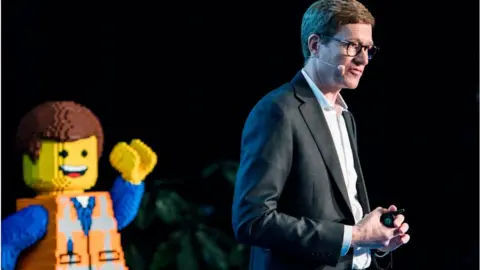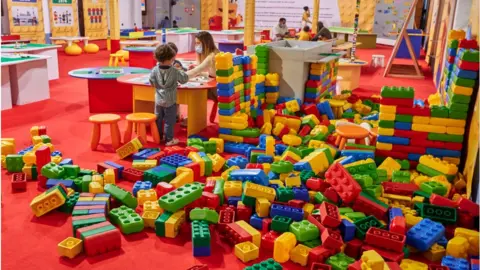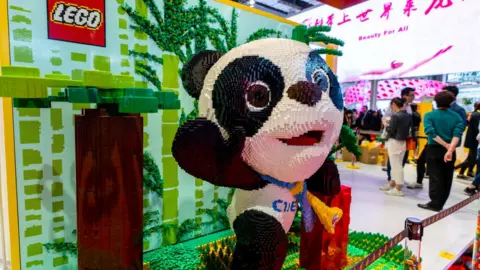Lego plans hiring spree for digital growth drive
 Getty Images
Getty ImagesDanish toy giant Lego plans to recruit hundreds of computer experts in the UK, Denmark and China to expand its digital games and online sales operation.
In 2020, the company saw its fastest sales growth in five years, helped by locked-down families buying bigger Lego sets they could make together.
But a new Super Mario set, which blends physical bricks with online games, has been one of the biggest launches ever.
Boss Niels Christiansen told the BBC Lego would speed up its digital plans.
The company has just released Lego VIDIYO, a partnership with Universal Music, which allows children to make their own music videos with special effects and filters.
"For the past two years we've made large-scale investments in initiatives designed to support long-term growth," the Lego chief executive said.
"We are accelerating our digital transformation. This is a big investment area for customers and suppliers," he said.
Store expansion
He told the BBC that every 2.77 seconds "someone uploads a Lego creation to our digital platforms that they have created and want to share. The Lego community is based on the brick, but this shows there is no limit to where we can take this."
While the Lego brick will always be at the heart of the business, he said: "Today's children are growing up in a digital world and they effortlessly blend online and physical play."
 Getty Images
Getty ImagesThe digital expansion will mean recruiting more computer games and website specialists over the next couple of years, said Mr Christiansen, who praised the UK's expertise in this sector. "We go where the talent is available. Where we find the best talent is in UK and Denmark. I think the number will be in the hundreds.
"We have a solid digital foundation, but must move faster. The past year has shown the importance of having an agile, responsive business built on strong digital foundations," Mr Christiansen said.
In addition to its 17 stores - and another due to open in Edinburgh soon - Lego has two UK offices and employs almost 750 people.
Despite store closures across the world due to the pandemic, and temporary production shutdowns at factories in China and Mexico, Lego saw a 19% jump in profits to 12.9bn Danish kroner (£1.5bn) for 2020. Revenues rose 13% to 43.7bn kroner (£5bn). Sales growth in all Lego's markets was in the double-digits.
Plastic alternative
Mr Christiansen said there had been an increase in sales of bigger, more complicated Lego sets. "Instead of buying Lego sets for kids, families were buying big sets and building them together," he said. And the growth in interest for adult Lego sets continues, he added.
A strong seller in 2020 - and a favourite of Mr Christiansen - was a complex Lamborghini car. However, his number one favourite is the traditional build-what-you-want box of bricks, which consistently remains in Lego's top ten best sellers each year.
 Getty Images
Getty ImagesDespite the pandemic, Lego continued with store openings - with another 134 new shops, including 91 in China, expanding the chain to 678. Lego plans to open another 120 sites in 2021, with 80 in China where development of the brand had not been as fast as in Europe and the US.
Mr Christiansen said bricks and mortar remained key to Lego's growth, in large part because "the shops are not about getting the product across the counter".
He said: "The stores are much more a brand-builder and experience outlet. A lot of the new stores will be in China. It makes a big, big difference if there is a store in town for creating awareness of the brand."
The company, founded in 1932 and still family-owned, is trying to find alternatives to plastic for its bricks. Lego said it could not give a figure for how many were made each year.
Mr Christiansen said Lego is investing heavily in researching new materials, but has already introduced more bio-based elements into the manufacturing. The plan remains to introduce a sustainable product by 2030.
Finding a quality, long-lasting material was not as easy as people might think.
"Lego sets will be used for 40, 50 years. They will still work even though they might have been lying in the basement until brought out for the grandchildren.
"That lasting quality needs to stay there even when we sustainably source. We cannot just go out and buy that material. We are actually trying to develop it," he said.